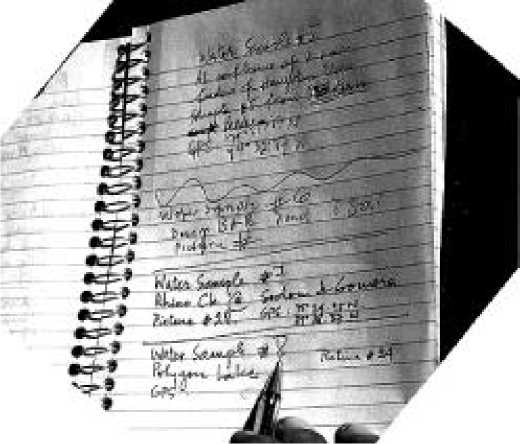WJ Clancey — Visualizing Practical Knowledge
Study individual notations and order of data collection
At a different level, we are interested in how the information created during field work is
recorded as data. In Figure 5 we are looking over the shoulder of a geologist, who is
assisting a physician in recording water samples. The notebook belongs to the physician,
but is being filled by the geologist. Who will use this data? For what purposes? Are the
these two people, like the biologist, imagining a journal article or technical report that
will be based on this data?

Figure 5: Shared field notebook (sample #6 was logged by the physician, all others
by the astrogeologist)
What if we automated the data recording process? Would we lose valuable ideas that are
occurring to the geologist as he writes down his observations? How is context recorded?
To answer these questions, we analyze the record in detail. We see a steady pattern in the
notebook, a kind of template that the geologist is following. In order, he logs the water
sample number, a brief description of the site, the picture taken at this site, and the GPS
(global positioning system) location information. Sometimes information is left out—a
picture number is not recorded. Examining his photographs would tell us whether he
forgot to take the picture or just didn’t enter the number.
When reviewing this enlarged photograph of the notebook with the geologist, I learned
that the physician made the second entry: He drew a squiggly line to show a break from
the geologist’s notes. The geologist then continued with the third and fourth entries,
12
More intriguing information
1. Measuring and Testing Advertising-Induced Rotation in the Demand Curve2. The ultimate determinants of central bank independence
3. Education Research Gender, Education and Development - A Partially Annotated and Selective Bibliography
4. The name is absent
5. The name is absent
6. The name is absent
7. Direct observations of the kinetics of migrating T-cells suggest active retention by endothelial cells with continual bidirectional migration
8. NATIONAL PERSPECTIVE
9. Studies on association of arbuscular mycorrhizal fungi with gluconacetobacter diazotrophicus and its effect on improvement of sorghum bicolor (L.)
10. The name is absent